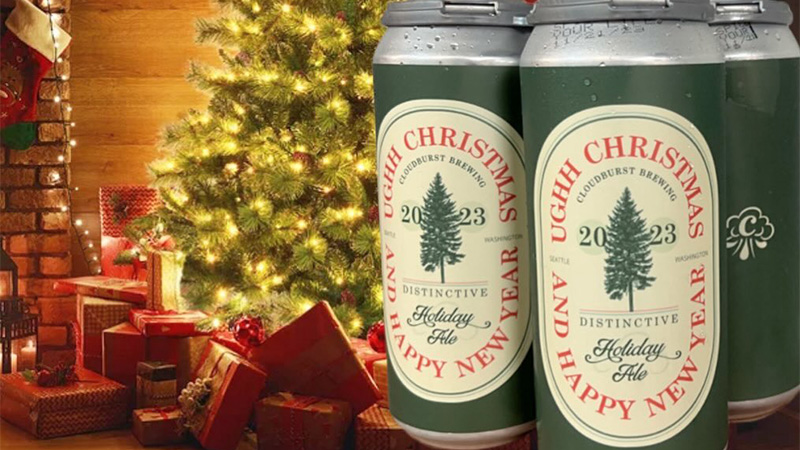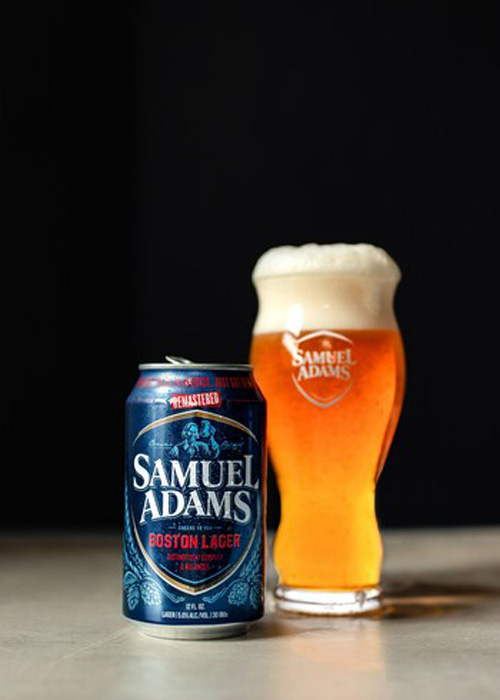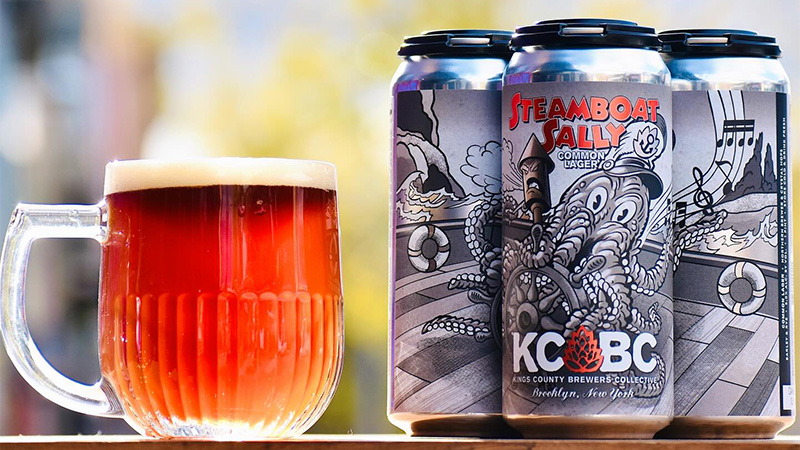For several years, Steve Luke pondered making a malty winter warmer, the strong spiced ale popularized by Anchor Brewing’s Christmas Ale, an annual tradition since 1975. However, “I didn’t know if we’d be able to sell 15 barrels,” says Luke, the founder and head brewer of Seattle’s Cloudburst Brewing.
But after Sapporo U.S.A. announced Christmas Ale’s end and then closed Anchor this summer, the loss opened a fragrant niche. “We felt there were enough people in our area that would be stoked if we filled that void,” Luke says.
Cloudburst brewed Distinctive Holiday Ale with a half dozen spices, including anise and grains of paradise, and packaged it in 16-ounce cans bearing an illustrated tree, a nod to Anchor’s memorable label.
Don’t Miss A Drop
Get the latest in beer, wine, and cocktail culture sent straight to your inbox.
Days before Thanksgiving, Cloudburst announced its nostalgic winter warmer with a self-deprecating Instagram post (it’s a “beer you can drink one can of [and] leave a second can in the back of your fridge”) that became a potent sales pitch. By early December, most cans disappeared from Cloudburst’s taprooms.

“We’ve already got 2024 queued up, and our designer is going to use the Charlie Brown Christmas tree,” Luke says of the scrawny cartoon tree.
American brewers regularly dig up buried styles like Germany’s tangy gose and dust off centuries-old recipes, using the past to build a new brewing future. But today’s beers are tomorrow’s history lessons, and breweries and beloved beers are rapidly disappearing. Instead of waiting for a half- century to revisit them, breweries are honoring brands soon after the pulse stops.
“The body was still warm,” Luke jokes.
Beloved Beers Don’t Have Permanent Perches on Store Shelves
As modern American beer boomed and coalesced over the decades, brands such as Anchor Steam, Samuel Adams Boston Lager, and New Belgium Fat Tire became fixtures on the national fermented landscape. Their bubbly presence seemed absolute, elders given front-row seating in store fridges.
Yet our society celebrates youth, and thousands of fizzy upstarts have entered the brewing industry. Drinkers regularly bypass enduring brands for the latest-model IPA. Have some dry-hopped flings! That trusty amber ale will always await, right?

No beer is immune from vanishing or evolving. Earlier this year, Boston Beer “remastered” Boston Lager, and New Belgium sent Fat Tire’s recipe biking into the sunset, revamping the amber ale as lighter and crisper to reverse sales declines. The outcry was as expected. I loved that beer I rarely bought!
“It’s something that we all wanted to drink and brings us back to our craft-beer roots.”
“When you don’t have the option to go out and just grab an amber ale off the shelf, all of a sudden you kind of crave it,” says Kaleigh Armitage, the marketing manager for Denver’s Crooked Stave.
The brewery was considering making a hoppy amber ale when the Fat Tire news dropped. The loss led to the October release of a one-off amber ale called Re-Tired, the label echoing Fat Tire’s red, white, and blue color scheme and trademark bicycle. (In advance of Re-Tired’s release, Crooked Stave had a friendly conversation with New Belgium about the beer and received the brewery’s blessing.)
“Why wait?” Armitage says. “It’s something that we all wanted to drink and brings us back to our craft-beer roots.”
Growing up in the Pacific Northwest, Zack Kinney often saw Anchor Steam in the family refrigerator. “My dad was drinking it,” says Kinney, a founder of Kings County Brewers Collective (KCBC) in Brooklyn.
In the wake of Anchor’s closure, the staff at KCBC started discussing steam beer, a style of warm-fermented lager. (Anchor trademarked the phrase “steam beer” in 1982; other breweries call it a California common.) This sparked a round of free association. Steam beer led to steamboats, opening a brewery on a boat, and Steamboat Willie, the precursor to Mickey Mouse. This created the concept for Steamboat Sally (Sally is KCBC’s cartoon octopus mascot), a “common lager” released in November.
“It all came together for the nostalgia and bittersweet sadness that we were feeling around Anchor Brewing closing,” Kinney says.
Cloning Beers Is About ‘Replicating Greatness’
Beer drinkers are awash in choices — fruit juice IPAs, chocolate cake stouts, and classic Czech pilsners available far and wide. The ubiquity makes it easy to forget that options and distribution were once more limited. Homebrewers filled in flavor gaps by brewing clones of popular beers, from Deschutes’ Black Butte Porter to Russian River’s Pliny the Elder double IPA.
The appeal is about “replicating greatness,” says Julia Herz, the executive director of the American Homebrewers Association, which offers numerous clone beer recipes. The recipes are invitations to replication and customization.
“You can tweak it to your taste,” Herz says. “Dare I say even sometimes making it better?”
Sometimes professional brewers unintentionally clone beloved beers. About five years ago, Jeff Bagby, the co-owner and head brewer of Bagby Beer in Oceanside, Calif,. was trying to make a standard American pale ale. “We tasted it out of the fermenter and I was like, ‘That really reminds me of something,’” Bagby says.
He did a side-by-side with the finished beer and Sierra Nevada Pale Ale, noting the similar color and ABV. “We didn’t seek out to make it,” Bagby says, adding the beer’s specs were probably imprinted in his brain.
The pale ale’s name, Copycat, “pays homage to the great one,” Bagby says, though it’s not a one-to-one replica. Copycat is a little more bitter, with a lighter dry hop. Moreover, Sierra Nevada uses whole-cone Cascade hops for its trademark pine and grapefruit character, not the more common pellets or extracts.
“It’s really hard to mimic that,” Bagby says.

Certain ingredients are tough to source for clone beers. KCBC had a difficult time finding herbal Northern Brewer hops, a key Anchor Steam ingredient. “Nobody brews with those hops anymore,” says Kinney, who tracked down Northern Brewer hops from Yakima, Wash., supplier Hollingberry & Son. “When we rubbed them, the sensory experience immediately put us in this Anchor Steam frame of mind,” he says.
In 2016, Denver’s Call to Arms parodied Coors Banquet Beer with Khores Ballroom Beer, which was made with “pure 1000% ice-cold Rocky Mountain spring water.”
However, Coors uses a distinct yeast strain and malts its own Moravian barley, neither of which are commercially available to brewers. Call to Arms instead used German malt and a campaign based upon a kitschy ad for the Coors sexy man who looks like an “Anchorman” extra.
“There’s a reason why these things aren’t around anymore.”
“I got a camel-hair jacket and every time we did a news piece or got interviewed for an event, I would wear it,” says owner and cofounder Chris Bell, who was filmed riding a tricycle and skiing. Molson Coors let the homage slide until Call to Arms packaged Khores in cans, leading to a cease-and-desist letter and good-natured resolution. Call to Arms dropped Khores and kept the Ballroom Beer name, and the lager remains a top two or three seller at the taproom. “There’s a cult following,” Bell says.
Crooked Stave will keep its Fat Tire homage on tap through March and hopes to make a hoppy amber ale a recurring cold-weather seasonal release. “Our sales team definitely thinks that there are legs,” Armitage says, though the brewery will change the name and remove the label’s bike.
Releasing an homage beer triggers nostalgia that translates to initial sales. But will customers buy it again? “There’s a reason why these things aren’t around anymore,” says Cloudburst’s Luke. A beer like Anchor Christmas Ale “has such favorable memories, but also it’s forgotten so easily for 11 months of the year, too.”
Done well, homage beer honors and respects tradition, keeping a beer’s memory current. There’s hope yet that Anchor will come back; Cloudburst’s in memoriam ale might be a placeholder until the brewery is revived. “We’re all rooting for that outcome,” Luke says.